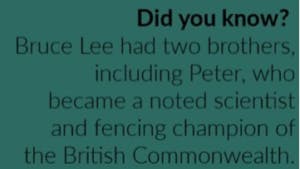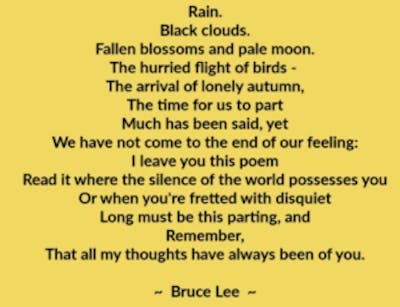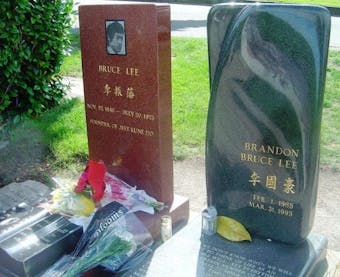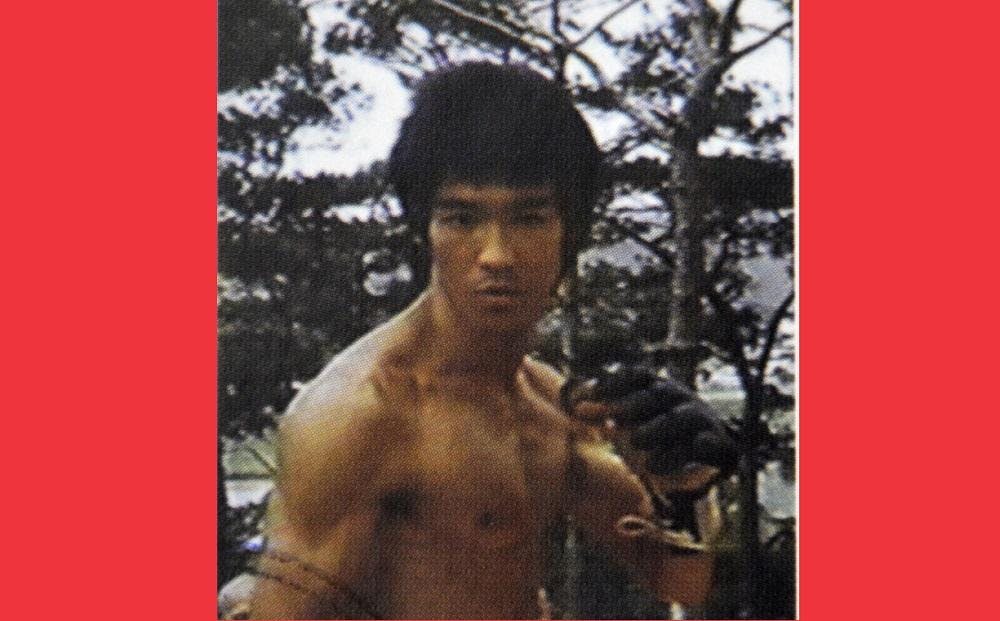“The key to immortality is first living a life worth remembering.” – Bruce Lee
Four decades after his passing, the name Bruce Lee continues to permeate modern culture.
Most people know Lee as an actor and martial arts extraordinaire. Some of Lee’s films were global blockbusters, lifting him to the status of greatest martial artist of the 20th century. He starred as the first Asian male lead in an American action film in Enter the Dragon (1973), the first Hong Kong/Hollywood-produced movie ever made – and Lee’s last.
Bruce Lee’s time in Seattle, though only five years, was some of his most formidable spent in America and where he thought deeply about what he wanted to do with his life. Seattle was where he attended schools of higher learning, established himself as a martial-arts icon and met his future wife.
Lee Jun-fan was born on Nov. 27, 1940 in San Francisco while his parents were touring with their Hong Kong-based Cantonese Opera Company. It is believed a nurse at the hospital gave Lee his American name of “Bruce.” After a childhood in Hong Kong, where he appeared in most of his 24 credited films, Lee arrived in Seattle in 1959. Lee’s mother, Grace, arranged for her son to live with influential restaurant owners Ping and Ruby Chow. Ping, a singer, had worked with Lee’s father, Hoi Chuen, in Chinese opera.
The Chows put Lee to work at Ruby Chow’s Restaurant, a converted mansion at 1122 Jefferson Street in First Hill. Lee lived and worked in the same building, bussing and waiting tables to cover his room and board. (In 1973, Ruby Chow became the first Asian-American to be elected to King County Council.)
At 19, Lee enrolled in Edison Technical College (now Seattle Central Community College) and graduated about a year later. Lee, an established martial artist in Hong Kong, demonstrated Gung Fu techniques locally, starting in the summer of 1959 at a Seafair event in Chinatown. He was noticed by judo expert Jesse Glover, who asked Lee to teach him Gung Fu, a form of martial arts that intersects philosophy with fighting.
Lee agreed and began to mentor Glover and others at the corner of Maynard Avenue South and South Lane Street. He would hold informal training in parking lots, basements and anywhere he could set up space. He later established the Jun Fan Gung Fu Institute in a storefront at 653 South Weller Street. His students were of all stripes, teaching non-Asians the martial arts when it was frowned upon by fellow Asians.
 He started attending the University of Washington in March 1961 and, recognizing the long commute between Chinatown and the University District, Lee moved his martial arts training school, or kwoon, in 1962 to a 3,000 sq. ft. ground-floor space in an apartment building that’s still standing at 4750 University Way. Its proximity to UW allowed Lee to work (and, yes, sleep) within a few blocks of campus.
He started attending the University of Washington in March 1961 and, recognizing the long commute between Chinatown and the University District, Lee moved his martial arts training school, or kwoon, in 1962 to a 3,000 sq. ft. ground-floor space in an apartment building that’s still standing at 4750 University Way. Its proximity to UW allowed Lee to work (and, yes, sleep) within a few blocks of campus.
Often an optimist and visionary, Lee had his sights on establishing a network of martial arts schools around the country. A young success in Hong Kong films, he also envisioned continuing his acting career to new heights in America.
In a letter to a Hong Kong friend, Lee wrote from Seattle: “I am not easily discouraged, and I readily visualize myself as overcoming obstacles, winning out over setbacks, achieving impossible objectives.”
Lee would often give demonstrations at schools, clubs and even at Seattle’s World’s Fair. He offered one display of his talents at Garfield High School, where he met 17-year-old homecoming queen Linda Emery, who would later also attend UW. Soon after meeting they started seeing each other, with their first date in October 1963 at the Space Needle’s revolving restaurant.
Lee also befriended many of his students, most notably Taky Kiruma, who would eventually take over the Seattle school from Lee.
“He was about 5-7 and weighed about 130 pounds,” Kiruma said, describing his friend in a story for The Seattle Post-Intelligencer in 1975. “But ounce for ounce he was the most powerful man I have ever seen.”
It was not uncommon for Lee to face challenges from others who were bigger and older than this smallish college student. Kiruma recalled one instance of a karate expert from Japan who confronted Lee at a Seattle handball court.
Kiruma told the P-I: “The karate expert lasted exactly 11 seconds.”
In his free time, Lee would enjoy watching films at the old Atlas Theatre on Maynard Street (between Jackson and King streets). He also frequented Tai Tung, 655 South King Street, founded in 1935 and going strong as the oldest restaurant in the International District.
 Lee took composition and poetry courses while at UW. Writings incorporated his experiences with nature in the Pacific Northwest such as visits to Washington Park Arboretum. He wrote about coupled birds, silvery moonlight, the sanctuary of lying in a boat on Lake Washington and even the Seattle rain.
Lee took composition and poetry courses while at UW. Writings incorporated his experiences with nature in the Pacific Northwest such as visits to Washington Park Arboretum. He wrote about coupled birds, silvery moonlight, the sanctuary of lying in a boat on Lake Washington and even the Seattle rain.
By June 1964, after about three years at UW, Lee abandoned his Philosophy studies and decided to move to California to further pursue martial arts teaching and acting.
Only two months later, Lee returned to marry Seattle sweetheart Linda Emery on Aug. 17, 1964, at the University Congregational Church on Northeast 45th Street in the U District, with Kiruma as Lee’s best man. The wedded couple moved to Oakland and less than a year later celebrated the birth of their first child, son Brandon, who would also become an actor and martial artist. A daughter, Shannon (a one-time actress and now president of the Bruce Lee Foundation), would arrive in 1969.
Bruce Lee had success in film and with his schools. He would name his own expression of martial arts, Jeet Kune Do, in 1967, translated as “the way of the intercepting fist.” He was clearly becoming a pop culture icon who accomplished so much in a short time.
On July 20, 1973, Lee was meeting with friends in the Hong Kong apartment of actress Betty Ting Pei. He complained of a headache and the actress gave him a painkiller prescribed by her doctor, according to published reports at the time. Lee laid down for a nap and the subsequent allergic reaction was fatal. (The death in her home damaged Ting’s career and in 2006 she acknowledged to having an affair with Lee at the time of his passing. The coroner listed the cause of death as “death by misadventure.”)
“My feeling is that Bruce was a man so intense that he actually worked himself to death,” Kiruma once told the P-I. “He was wound up like a high-performance racing engine. And when an engine is wound up that tight anything can happen.”
A man, aged 32, who seemed indestructible was dead and the world was in shock. Only 14 years after arriving in Seattle, he was coming “home” for a final time.
An estimated 25,000 people attended Lee’s funeral in Hong Kong. His body was then flown to Seattle and attendance for a private memorial service was limited to about 180. Among the pallbearers were actors (and Lee devotees) James Coburn and Steve McQueen and close friend Kiruma.
 Lee was buried at Lake View Cemetery in north Capitol Hill for many reasons. One of Lee’s earliest students in Seattle was a young man named Charlie Woo, who died from the effects of being kicked in the head by a horse. Charlie was buried at Lake View. Lee’s wife, Linda, thought it would be nice to make the same cemetery his final resting place. She choose a plateau that would offer a view of the university campus, Lake Washington and of Charlie’s grave just below.
Lee was buried at Lake View Cemetery in north Capitol Hill for many reasons. One of Lee’s earliest students in Seattle was a young man named Charlie Woo, who died from the effects of being kicked in the head by a horse. Charlie was buried at Lake View. Lee’s wife, Linda, thought it would be nice to make the same cemetery his final resting place. She choose a plateau that would offer a view of the university campus, Lake Washington and of Charlie’s grave just below.
Sadly, the story did not end with the sudden end to Bruce Lee. Nearly 20 years later – March 31, 1993 – Lee’s son, Brandon, died while on a movie set in North Carolina when an empty bullet casing was accidentally fired at effectively the same force as a normal bullet, killing the 28-year-old actor within hours.
Brandon’s remains were buried beside his dad where they will rest forever. Now, the dual Lake View gravesite is a solemn tourist attraction for thousands of people to visit and reflect every year.
For more information on Bruce Lee, the Wing Luke Museum offers an ongoing exhibit and street tour of Lee’s time in Seattle’s Chinatown International District.
Note: We revisited Lake View Cemetery in 2023. Check out this video blog post: “Lake View Cemetery – Final Resting Place to Seattle’s Greatest Gifts, Its People“.




